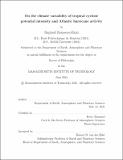| dc.contributor.advisor | Emanuel, Kerry | |
| dc.contributor.author | Rousseau-Rizzi, Raphaël | |
| dc.contributor.other | Massachusetts Institute of Technology. Department of Earth, Atmospheric, and Planetary Sciences. | |
| dc.date.accessioned | 2021-12-07T20:03:53Z | |
| dc.date.available | 2021-12-07T20:03:53Z | |
| dc.date.copyright | 2021 | |
| dc.date.issued | 2021 | |
| dc.identifier.uri | https://hdl.handle.net/1721.1/138368 | |
| dc.description | Thesis: Ph. D., Massachusetts Institute of Technology, Department of Earth, Atmospheric, and Planetary Sciences, June, 2021 | |
| dc.description | Cataloged from the official PDF of thesis. | |
| dc.description | Includes bibliographical references (pages 143-157). | |
| dc.description.abstract | From a meteorological standpoint, the most important questions one needs to answer about a given tropical cyclone is how strong the winds generated by the event can become. From a climatological standpoint, it is critical to predict tropical cyclone activity, or the collective destructive potential of all tropical cyclones in a given basin and during a given period. Potential intensity (PI) is defined as a thermodynamic bound on tropical cyclone maximum wind speeds, and is a good predictor of the intensity of a single event but also of tropical cyclone activity. As such, PI is a useful quantity to help answer both meteorological and climatological pressing questions about tropical cyclones. First, this thesis adresses recent controversies about whether the PI assumptions of inviscid free troposphere and steady-state make it inapplicable. Comparing various forms of the PI bound to the corresponding bounded quantities in low-mixing axisymmetric simulations shows that PI is in fact a valid bound on tropical cyclone intensity. Then, a categorization of definitions of tropical cyclone steady state used in the literature is introduced to clarify the conditions in which simulations can be compared to theories such as PI. It is shown that most intensity theories can be compared to the simulated period surrounding peak tropical cyclone intensity, while theories for the structure of the storm requires the simulated storm to have come into equilibrium with the surrounding environment. Next, turning to climate, a linear model for interannual basin-wide PI variations is developed, which captures almost all the PI variance in reanalysis products and provides a way to partition global and local contributions to PI variations. The model notably shows that tropical North-Atlantic PI variations over the last 40 years have been dominated by local influences. The final part of the thesis evaluates the causes of the Atlantic hurricane drought of the 1970s and 1980s. An anthropogenic nature of the hurricane drought is proposed. Concurrent hemispherically asymmetric anthropogenic sulfate emissions caused a drying of the Sahel region and enhanced the emissions of eolian dust from the Sahara and the Sahel which is shown to be detrimental to hurricane activity. | en_US |
| dc.description.statementofresponsibility | by Raphaël Rousseau-Rizzi. | |
| dc.format.extent | 161 pages | |
| dc.language.iso | en_US | en_US |
| dc.publisher | Massachusetts Institute of Technology | en_US |
| dc.rights | MIT theses may be protected by copyright. Please reuse MIT thesis content according to the MIT Libraries Permissions Policy, which is available through the URL provided. | |
| dc.rights.uri | http://dspace.mit.edu/handle/1721.1/7582 | |
| dc.subject | Earth, Atmospheric, and Planetary Sciences. | en_US |
| dc.title | On the climate variability of tropical cyclone potential intensity and Atlantic hurricane activity | en_US |
| dc.type | Thesis | en_US |
| dc.description.degree | Ph.D. | |
| dc.contributor.department | Massachusetts Institute of Technology. Department of Earth, Atmospheric, and Planetary Sciences | |
| dc.description.collection | Ph.D. Massachusetts Institute of Technology, Department of Earth, Atmospheric, and Planetary Sciences | |
| mit.thesis.degree | Doctoral | |
| mit.thesis.department | EAPS | |
